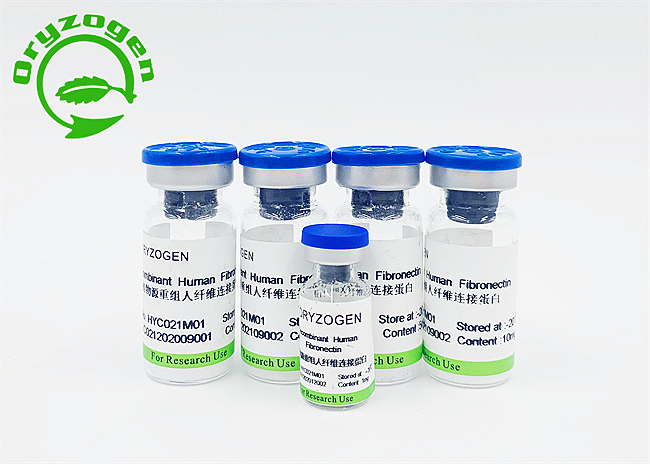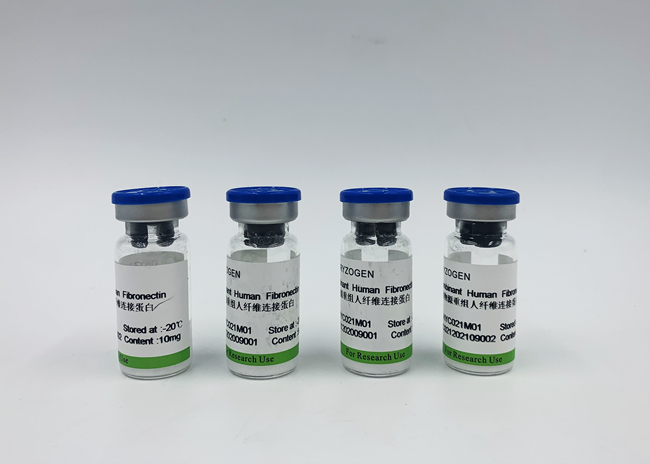Application of plant-derived Recombinant Fibronectin in diagnose reagents
Fibronectin (Fn), is mainly synthesized by liver and vascular endothelial cells, and widely found in animal plasma, body fluids and tissues. It's a large molecular glycoprotein with a molecular weight of 220-250 KD in monomer, 450 KD in dimer, and has various biological activities. Modern medical research has shown that changes of fibronectin content in human body are closely related to a variety of clinical diseases, which means the detection of fibronectin content is of great clinical importance.

Molecular structure of Fibronectin
At least 20 kinds of fibronectin have been identified. Each subunit of fibronectin are the expression products from the same gene, but different mRNA because they are different in the RNA cleavage after transcription. Each subunit of fibronectin consists of several structural domains with high affinity binding sites for cell surface receptors, collagen, fibrin, and proteoglycan sulfate.
Plant-derived Recombinant Human Fibronectin (OsrhFn) is expressed by rice endosperm specific high expression platform OryzHiExp , and obtained by protein isolation and purification technology, which retains the complete functional structural domain. The monomer molecular weight of OsrhFn is about 210kD. The purity is more than 95% tested by SDS-PAGE, and the endotoxin is less than 0.5 EU/ug.
Biological functions of fibronectin
The function of fibronectin in human body are complex. It is now known that fibronectin is associated with cell to cell adhesion, cell migration and chemotaxis, thus playing a role in anti-inflammation, tissue repair and wound healing. Fibronectin has a strong effect in promoting phagocytic function of mononuclear macrophages, has non-specific opsonin activity, and has important significance in anti-infection, clearing immune complexes, and promoting oncogene transformation.
Fibronectin is present in the alpha granules of platelets. Thrombin and collagen cause platelets to release fibronectin and secrete it onto the platelet surface. During the clot formation, fibronectin promotes platelet attach to the damaged part of the blood vessel. In the final stage of coagulation, coagulation factor FxⅢa can catalyze covalent binding of fibronectin and fibrin. Fibronectin participates in the coagulation process through coagulation factor Ⅻ. In the case of endothelial damage and collagen exposure, fibronectin can adjust the relationship between fibrin and collagen, accelerate removal of fibrin and its degradation products, maintain the dynamic balance of coagulation and fibrinolysis, and have an anti-thrombotic effect.
Plant-derived Recombinant fibronectin (OsrhFn) can enhance intercellular adhesion and cell-matrix adhesion. By adhesion, fibronectin can regulate cell shape and cytoskeleton organization through cell signaling pathways, promote cell adhesion growth, proliferation, differentiation, and facilitate cell spreading, migration and motility.

Clinical significance of fibronectin
Because fibronectin has a very complex biological function, its content changes are closely related to severity and outcome of many clinical diseases. In the clinical diagnosis of the following eight diseases, the measurement of fibronectin content has very important clinical significance.
1 Hepatitis and liver cirrhosis
The change of fibronectin content in patients with infectious hepatitis is related to the stage of the disease. The plasma fibronectin level decreases in the active stage in acute hepatitis, severe hepatitis, decompensated cirrhosis, liver cancer and especially extensive liver metastases. The rise of serum fibronectin level indicates improvement of the condition.
2 Coronary heart disease
The plasma fibronectin content of patients with coronary heart disease is increased. This high fibronectin status promotes the repair of necrotic myocardium; on the other hand, promotes platelet adhesion to the damaged parts of blood vessels, accelerates the removal of fibrin and its degradation products, and maintains the dynamic balance of coagulation and fibrinolysis, and has an anti-thrombotic effect.
3 Malignant tumors
The plasma fibronectin levels in patients with gastrointestinal tumors such as esophageal cancer, gastric cancer, liver cancer and colorectal cancer were lower than those normal control group, indicating that plasma fibronectin in patients with gastrointestinal tumors is involved in the opsonization and decreased the level. The fibronectin level in tumorous effusion is higher than those other infectious and non-specific effusions, therefore, it has important value for detecting early tumor infiltration, guiding treatment and predicting prognosis.
4 Hematological diseases
Plasma fibronectin (PFn) in patients with acute leukemia and sepsis is significantly lower than the normal value, which is presumably caused by the massive consumption of PFn. When the disease improves, its level also gradually rises and reaches a normal level after recovery.
5 Diabetes
In type II diabetic patients, plasma fibronectin is significantly reduced. After hypoglycemic drugs treatment, the fasting blood glucose decreases not significantly, but plasma fibronectin increases significantly and negatively correlates with fasting blood glucose. Therefore dynamic monitoring of PFn us useful for observing the condition of diabetic patients.
6 Preterm labor screening
The amniotic fluid and cervicovaginal secretions contain only small amounts of fetal FFn during normal mid and late pregnancy. When contractions occur in preterm labor, the chorion-decidua interface is broken and FFn penetrates into the amniotic fluid and cervix, resulting excess FFn in the cervicovaginal secretions. Therefore, the detection of FFn levels provides a monitoring for the prevention of premature labor and the maintenance of perinatal maternal and child health.
7 Pregnancy-induced hypertension syndrome
The plasma fibronectin level in patients with pregnancy-induced hypertension is significantly higher than normal, and the PFn level increases with the aggravation of hypertension and increases in the number of weeks of pregnant. The PFn level in pregnant women with moderate and severe pregnancy-induced hypertension is significantly higher than those in mild gestational hypertension, and the difference is significant. Therefore, the PFn level can be used as an indicator to monitor the occurrence and severity of gestational hypertension syndrome.
8 Rheumatoid arthritis
In patients with rheumatoid arthritis, due to the need of repair after tissue damage, there may be accelerated biosynthesis of cellular CFn partially or around the lesion, and some CFn enters blood, which leads to secondary increase of CFn in plasma. Therefore, the change of CFn concentration may be used as an important indicator for the observation of efficacy and prognosis judgement.
Advantages of OsrhFn in clinical diagnostic reagents
Currently, the fibronectin in the market mainly is extracted from imported human plasma or animal plasma, which is a subsidiary product of blood products and has relatively more manufacturers, but with low and unstable capacity. The recombinanat human fibronectin has relatively less manufacturers, while the capacity is low and expensive, and most of them are 40-50KD small molecule fragments. Is there any recombinant human fibronectin that has high quality, low price and stable supply?
The plant-derived recombinant human fibronectin (OsrhFn) produced by Healthgen Biotech through rice endosperm specific high expression platform, OryzHiExp. It can be used in clinical diagnostic reagents for fibronectin index detection with advantages:
1、OsrhFn is a large molecular protein with a monomer molecular weight of about 210 KD, which is close to the natural human plasma fibronectin PFn, retaining the complete functional structural domain and having the same antigen, antibody binding site as PFn.
2、OsrhFN has a high purity of more than 95% and has a low endotoxin less than 0.5 EU/ug,with low background value that can avoid false positives.
3、OsrhFN, expressed through rice endosperm specific high expression plaform, with consistent raw materials, no fermentation and cell culture process, has large batch capacity, small batch-to-batch variation and high stability.
4、OsrhFN has been produced on a large scale, and can be supplied in large quantities and at a very stable price.





